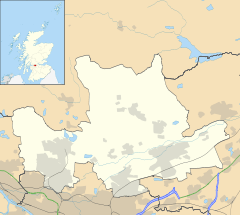Clachan of Campsie
Coordinates: 55°59′18″N 4°13′47″W / 55.9882°N 4.2297°W
Clachan of Campsie or Campsie Glen (Scottish Gaelic: Clachan Chamais) is a settlement now in the East Dunbartonshire area of Scotland. It was formerly part of the county of Stirlingshire. It is situated to the south of the Campsie Fells at the foot of Campsie Glen where the Finglen and Aldessan Burns meet, forming the Glazert Water which then flows south-east until it joins the River Kelvin near Kirkintilloch.
In it are old industries, Crow Road, Jamie Wright's well, Lennox Castle, Woodhead House, St Machan's Church, and Campsie Glen.
Clachan of Campsie used to be the main town of the area until Lennoxtown started being built that was then called "New Campsie". Campsie Glen was a busy place in those times and has slowly died down until now with not many houses left.
Schoenstatt
Originally called Ballencleroch House, the shrine of Schoenstatt in Clachan of Campsie is a place, with gardens and a shrine to Our Lady of Schoenstatt, where nuns worship God. Since 1989, families, individuals and groups have been able to go there and come back with many comments of how beautiful and peaceful it is there. There is a woodland walk in Schoenstatt and there are other areas you can explore that most people will find fantastical.
History
In early 1962, Sister Xavera brought Schoenstatt to Scotland by building a centre for German catholic residents. Sister Vincetas later joined her and they worked together for many years in Ardmory in the south of Glasgow. They worked in a large area of Scotland down to Manchester. The looked after German ex-soldiers and lots of others. After time, Schoenstatt began to grow and slowly a small family Movement began to appear. Sister Xavera had a wish that a shrine could be built, and very slowly things began to arrive such as the altar in the 1970s and then the vocations in the 1980s. Father Duncan McVicar and Father Bryan Cunningham were ordained as priests at Schoenstatt. Sister Mary-Elsbeth Owens and Sister Marion McClay joined the Schoenstatt movement with Father Michael Savage who joined the Schoenstatt Priest's Institute. The move to establish a shrine came when with Sister Margareta and Sister Patricia. The shrine was opened in Campsie Glen in 1989 and then the Formation Centre in 1995. Neighbours in the area call the shrine nowadays "The Schoenstatt".
Geography
Houses are dotted around the square and along Crosshouse Road. Some live along Knowhead Road where there is an entrance to the Schoenstatt and if you go further up the road there will be a farm. It will then lead you onto the hill where there are some tracks that lead around the place. If you walk far you can find ruins, pools, waterfalls and all sorts. After the farm you can also go down to the river which if you cross (on a plank of wood that is quite thin) and go up the hill that way you will come to the ruin of a small Cottage.
Going along Crosshouse road will lead you onto many fields (the Right of Way) and you will end up at the bottom of Lennoxtown. There are many bogs and you are likely to see lots of different objects stuck in the mud.
From the square you can also go up past Wheelcraft onto a little path that has been vandalized over the years by teenagers not caring about the countryside. There used to be two wood carvings of an old man and an old woman's head. You will slowly see the Glazert along beside you that is slowly travelling away from you. There are also benches there carved out of wood. Most of them have been vandalized also. One bench is also in the little wood further back, next to the path which you can get to by going over the fence and down another path. Further up the path there is a rope-swing and further than that there is "The Big Hand" that tells you not to go further. You can go further though and the path will be much muddier and the river will be next to you. Along that way is waterfall. Also, back on the main path, a bit after you've gone past Wheelcraft there is another path that leads you to the wishing stone, then the Crow Road Carpark, then the hill. Or, from the wishing stone you can go down the path to a pool which you can swim in but be careful. There could be a dead sheep in it. On the hill there is a small building used for spotting planes during the second world war and further up there are the cairns (small piles of stones). When you go up remember to bring a stone to put on a cairn.
St Machan
Kincaids of Campsie
In the graveyard there is a mausoleum of the Kincaids.
Notes
There was once a Campsie Glen Curling Club.
References
External links
| Wikimedia Commons has media related to Clachan of Campsie. |
- Canmore - Clachan of Campsie, St Machan's Church
- Saint Paul's, Milton - History of St. Machan's Church, Campsie

